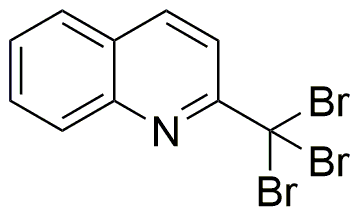2-Tribromomethylquinoline is widely utilized in research focused on:
- Pharmaceutical Development: This compound serves as a key intermediate in synthesizing various pharmaceuticals, particularly in developing anti-cancer agents due to its unique brominated structure that enhances biological activity.
- Material Science: It is used to create specialized polymers and coatings, offering improved thermal stability and resistance to degradation, making it valuable in the production of high-performance materials.
- Analytical Chemistry: The compound is employed as a reagent in analytical methods to detect and quantify other substances, providing researchers with a reliable tool for chemical analysis.
- Environmental Studies: It plays a role in studying the degradation of pollutants, helping researchers understand the environmental impact of brominated compounds and develop strategies for remediation.
- Organic Synthesis: This chemical is utilized in various organic synthesis reactions, allowing chemists to create complex molecules efficiently, which is essential in both academic and industrial settings.
General Information
Properties
Safety and Regulations
Applications
2-Tribromomethylquinoline is widely utilized in research focused on:
- Pharmaceutical Development: This compound serves as a key intermediate in synthesizing various pharmaceuticals, particularly in developing anti-cancer agents due to its unique brominated structure that enhances biological activity.
- Material Science: It is used to create specialized polymers and coatings, offering improved thermal stability and resistance to degradation, making it valuable in the production of high-performance materials.
- Analytical Chemistry: The compound is employed as a reagent in analytical methods to detect and quantify other substances, providing researchers with a reliable tool for chemical analysis.
- Environmental Studies: It plays a role in studying the degradation of pollutants, helping researchers understand the environmental impact of brominated compounds and develop strategies for remediation.
- Organic Synthesis: This chemical is utilized in various organic synthesis reactions, allowing chemists to create complex molecules efficiently, which is essential in both academic and industrial settings.
Documents
Safety Data Sheets (SDS)
The SDS provides comprehensive safety information on handling, storage, and disposal of the product.
Product Specification (PS)
The PS provides a comprehensive breakdown of the product’s properties, including chemical composition, physical state, purity, and storage requirements. It also details acceptable quality ranges and the product's intended applications.
Certificates of Analysis (COA)
Search for Certificates of Analysis (COA) by entering the products Lot Number. Lot and Batch Numbers can be found on a product’s label following the words ‘Lot’ or ‘Batch’.
Numéro de catalogue
Numéro de lot/série
Certificates Of Origin (COO)
This COO confirms the country where the product was manufactured, and also details the materials and components used in it and whether it is derived from natural, synthetic, or other specific sources. This certificate may be required for customs, trade, and regulatory compliance.
Numéro de catalogue
Numéro de lot/série
Safety Data Sheets (SDS)
The SDS provides comprehensive safety information on handling, storage, and disposal of the product.
DownloadProduct Specification (PS)
The PS provides a comprehensive breakdown of the product’s properties, including chemical composition, physical state, purity, and storage requirements. It also details acceptable quality ranges and the product's intended applications.
DownloadCertificates of Analysis (COA)
Search for Certificates of Analysis (COA) by entering the products Lot Number. Lot and Batch Numbers can be found on a product’s label following the words ‘Lot’ or ‘Batch’.
Numéro de catalogue
Numéro de lot/série
Certificates Of Origin (COO)
This COO confirms the country where the product was manufactured, and also details the materials and components used in it and whether it is derived from natural, synthetic, or other specific sources. This certificate may be required for customs, trade, and regulatory compliance.


